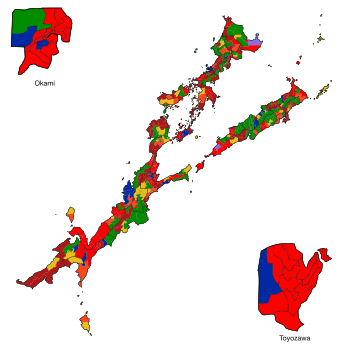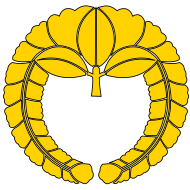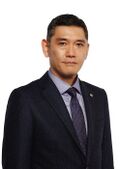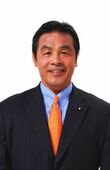Okaiken general election, 2016
|
| |||||||||||||||||||||||||||||||||||||||||||||||||||||||||||||||||||||||||||||||||||||||||||||||||||||||||||||||||||||||||||||||||||||
| |||||||||||||||||||||||||||||||||||||||||||||||||||||||||||||||||||||||||||||||||||||||||||||||||||||||||||||||||||||||||||||||||||||
|
| |||||||||||||||||||||||||||||||||||||||||||||||||||||||||||||||||||||||||||||||||||||||||||||||||||||||||||||||||||||||||||||||||||||
All 475 seats to the House of Commoners of Okaiken: 475 Direct Party and Representative Voting System (DPR) 247 seats needed for a majority | |||||||||||||||||||||||||||||||||||||||||||||||||||||||||||||||||||||||||||||||||||||||||||||||||||||||||||||||||||||||||||||||||||||
|---|---|---|---|---|---|---|---|---|---|---|---|---|---|---|---|---|---|---|---|---|---|---|---|---|---|---|---|---|---|---|---|---|---|---|---|---|---|---|---|---|---|---|---|---|---|---|---|---|---|---|---|---|---|---|---|---|---|---|---|---|---|---|---|---|---|---|---|---|---|---|---|---|---|---|---|---|---|---|---|---|---|---|---|---|---|---|---|---|---|---|---|---|---|---|---|---|---|---|---|---|---|---|---|---|---|---|---|---|---|---|---|---|---|---|---|---|---|---|---|---|---|---|---|---|---|---|---|---|---|---|---|---|---|
| Opinion polls | |||||||||||||||||||||||||||||||||||||||||||||||||||||||||||||||||||||||||||||||||||||||||||||||||||||||||||||||||||||||||||||||||||||
| Turnout | 87.35% | ||||||||||||||||||||||||||||||||||||||||||||||||||||||||||||||||||||||||||||||||||||||||||||||||||||||||||||||||||||||||||||||||||||
|
| |||||||||||||||||||||||||||||||||||||||||||||||||||||||||||||||||||||||||||||||||||||||||||||||||||||||||||||||||||||||||||||||||||||
 Results of the General Election. | |||||||||||||||||||||||||||||||||||||||||||||||||||||||||||||||||||||||||||||||||||||||||||||||||||||||||||||||||||||||||||||||||||||
| |||||||||||||||||||||||||||||||||||||||||||||||||||||||||||||||||||||||||||||||||||||||||||||||||||||||||||||||||||||||||||||||||||||
| Okaiken |
 This article is part of the series: |
|
|
|
Constitution
Judiciary
Prefectures
Elections
Foreign relations
|
|
Other countries · Atlas Politics portal |
The 58th general election of members of the House of Commoners (第58回衆議院議員総選挙 dai-gojūhachikai Shūgiin giin sōsenkyo) is due to take place on or before 1 January 2017, a barring by Constitution of Okaiken. After deliberations from the ruling Liberal Democratic Party, the election was set to July 25, 2016. Voting will take place in all Representatives constituencies of Okaiken including proportional blocks, in order to appoint Members of Diet to seats in the House of Commoners, the lower house of the National Diet of Okaiken. As the cabinet has to resign after a general House of Representatives election in the first post-election Diet session (Constitution, Article 70), the lower house election will also lead to a new designation election of the prime minister in the Diet, and the appointment of a new cabinet (even if the same ministers are re-appointed).
The date is set on July 25th, 2016, more than 3 years after Toshiro Kurosawa took over the office from Sasuke Genba. Honda Shigetsuma, the leader of the Progressive Party of Okaiken, is participating in his second election as the leader of the PPO.
The election saw the defeat of the Liberal Democratic Party for the first time since 1990 and the first time the Communist Party had taken power in the country.
Background
The general elections are usually scheduled every four years, with 2013 being the last election. It was originally announced by Kurosawa Toshiro that the elections would be held in 2017 at the very latest, but increasing pressure from the Sanese public and the unpopularity of several austerity bills meant that his mandate is quickly deteriorating. Hence, on March 2016, Kurosawa announced his intention to dissolve the parliament and begin an election period of more than 80 days, the longest campaign period in Sanese History.
Election campaign
The Pre-election polling for the 2016 election began on 15th of April, 3 months before the elections are to take place. Kurosawa, who had received mixed reviews on his handling of the cabinet, as well as his age, placed him in a vulnerable position to the other party leaders. The 42 year old Shigetsuma, with 6 years serving the Sanese Diet, was seen to be more experienced and more suitable according to the KTK polls. In the 15th of April Poll by KTK, Kurosawa is on the lead for less than 1 percentage point, well through the margin of error. In the Toyozawa Area, another poll by the Toyozawa Nichi Nichi Shinbun shows Honda Shigetsuma in the lead, also within the margin of error. The party continued to lead against the LDP, with the approval rating of the party reaching historic lows by April 25.
Meteoric rise of the Communist Party
By May 1st, there was a noted surge of the Sanese Communist Party, headed by Kazuo Shii. The party's handling of affairs and the increasingly vocal criticism of the Paraña Bank Scandal proved to be popular with voters. However, on the 8th of May, Kazuo Shii surprisingly resigned from the party, citing a deteriorating health and a need for newer, younger members to join the party. He was replaced by Sho Aoyagi, the deputy leader of the Sanese Communist Party. By the time the SCP had replaced Shii with Aoyagi, support for the party had risen to 17.4 percent, the highest the party had seen on its history.
The Communist Party continued its meteoric rise; by the 22nd of May, it had tied with the Progressive Party of Okaiken for the lead in the House of Commoners. The PPO, which maintained its lead during the party, lauded the shift to the left after the centrist-right rule of the LDP, which had been in government since the 1990s. The last non-LDP leader to hold the premiership in Okaiken was Honda Shigetsuma's father Honda Shigehara. By early June, it had seen its first lead in the polls.
LDP leadership crisis
In the House of Officers, the LDP continued to struggle, losing its key ministers Chikasado Keiji and Hatoyama Yukimasa to the Sanese Communist Party. By May 25th, the LDP suddenly announced that there will be a vote of confidence against Toshiro Kurosawa, which had been the head of the party for more than three years, sparking a new leadership crisis; many of the members of the LDP were recommending to replace the inexperienced Kurosawa to either Watanabe Harunobu or Sato Misashi, the ministers of defence and education respectively.
On June 3rd, an emergency meeting by the LDP was announced in Okami. Sadakazu Tanizaki, one of the candidates who had run against Kurosawa in the 2013 leadership caucus, announced his intention to serve as the new leader of the party, saying that he had the support of Watanabe and Sato as well as the rest of the caucus to unseat Kurosawa from the premiership. This sparked a climactic point into the leadership crisis and seriously damaging the LDP's ratings in national polling. 20 members of the LDP announced their intention to leave the party at 12:30p.m., citing their intention to move to NKT. Another meeting at 1:15p.m. was set for leadership voting. During the voting, 10 LDP members walked out of the voting session to protest the "coup" by Sadazaku. Kurosawa remained defiant of his position as the leader of the party, citing that the Paraña Bank Scandal "accounts did not go directly to the LDP caucus but rather at the hands of people like Sadakazu". At 4:39p.m., however, Kurosawa relinquished his position as the leader of the party, effectively ending his tenure as the Prime Minister. Several of his cabinet members also resigned from their positions, including the majority of the transitional committee during the elections, further deepening the leadership crisis of the LDP. At 6:20p.m., 23 members of the LDP, including the now-deposed Kurosawa, left the caucus. Some 45 minutes later, Kurosawa, along with 8 members of the house of representatives were in talks with Honda Shigetsuma to join his caucus on the Progressive Party as backbenchers. Honda Shigetsuma did not release the details to the public, remaining to be neutral the conflict; however, he is considering Kurosawa's plea to join his party. 12 members that left the caucus asked to join Sho Aoyagi's Communist Party. Aoyagi declined to comment but he eventually accepted the 12 members to join his caucus, albeit in the backbench position. 3 members of the party remained independent.
Leaders' debates
The first of two leaders' debates was held on June 15th by KTK, Okaiken's public broadcaster. In the run up to the debate, the two opposing sides, primarily the SCP-PPO coalition, focused their criticism to the ruling LDP's handling of its leadership crisis which kicked former Prime Minister Kurosawa from the caucus and the party. Sadakazu Tanizaki, the new LDP leader, said that the LDP's leadership elections were based on the Liberal Democratic Party Constitution, which can recall their leaders when they are unable to execute the party's administration. PPO leader Honda Shigetsuma criticized Tanizaki, saying that the LDP had lost its appeal to the people, proven by their low ratings after the bank scandal and the leadership crisis. Kurosawa remained silent over his ejection from the leader's seat and from the party, only stating that the LDP had got it wrong into launching a recall vote in the middle of the election campaign and he would not make a further comment into it. The Communist Party (SCP), on the other hand, launched a series of popular campaign ads that is calling for change in the National Diet. Prior to the debate, the Communist Party is statistically tied with the PPO in terms of popularity. Both the SCP and the PPO reassured their continuing cooperation in their coalition.
During the leaders' debate, both the SCP and the PPO attacked the LDP camp, citing the bank scandal as the root cause of the leadership crisis and the former Prime Minister Kurosawa was a scapegoat in order for the Tanizaki faction of the LDP to take over the party. Sho Aoyagi additionally added that Tanizaki may have been owned one of the bank accounts mentioned in the scandal. The LDP continued their denial over the bank crisis, blaming Kurosawa and the other members of the party for the creation of the bank accounts.
On other issues, the SCP criticized the LDP for failing to provide protection for workers and easing the 2005 law that restricts the use of cigarettes inside building facilities. The LDP responded that the rule had been redundant as it was taboo anyway for people to smoke inside the building. However, the SCP pointed out that in the year 2014, the number of cigarette related fires had jumped 30% due to the easing of the 2005 law. The PPO then attacked the LDP's economic record, stating that Okaiken had been stagnant since they had last took over in 1993, when the LDP defeated Honda Shigetsuma. The LDP responded that the ironically named "Kuronomics" had been working in the past year, and recent data shows an increase in the overall economy of the country. The PPO responded that the 'growth' that the LDP is describing is not enough to offset the ballooning debt of the country.
The second and final debate was held on July 20th, 5 days before the election period and was deemed to be as the penultimate event for the parties to convince the general public. This time, the PPO launched its attacks against the New Komeito Party, stating that their platform of conservatism and religion undermine the freedoms and values of the Sanese public. New Komeito leader Junichiro Okada responded to the allegations that the far left parties are the one that had been undermining the freedoms of the Sanese public. The two then engaged in shouting before the moderator intervened in the situation. The Sanese Communist Party remained calm during the confrontation calling for patience and control. The Liberal Democratic Party, on the other hand, tried to name all the accomplishments that they had done to Okaiken over their several years in power.
More issues arose from the debate, including the Adonian Games scandal during the term of Kurosawa. Tanizaki rebuked the argument by Shimane Yoshida, saying that the 400 million En allocated to the marketing program to the games were not given to officials through a 5% kickback. However, Yoshida stated that the 5% kickback itself was used to run the 2013 campaign of Kurosawa to gain the majority of the house. Honda Shigetsuma also added that through the defecting members of the LDP, including Kurosawa, they managed to uncover more of the LDP's practices to undermine Sanese Democracy. Other issues that were discussed in the debate include the Ameka Islands Dispute, the economy and social programs.
Rise of the third parties
With only 25 days left in the election cycle, there was a considerable rise in support for third parties. The Okaiken Social Democrats, headed by Shimane Yoshida, had a gradual increase in polls with the expense of the PPO and the Communist Parties. Although it only had two seats in the National Diet, it nevertheless acts as a broker between the ruling LDP and the PPO. However, by July 9th, its support gradually decreased with most support going to the Socialist Party, headed by Oizumi Yu.
Another third party that started to rise within the election period is the party of Kei Yamada, who heads the "Kei Yamada and friends party". Yamada's platform included a decrease in taxes for small businesses and allowing corporations to gain control of the benefits program. These proved to be popular with conservative groups in Okaiken, which do not have a representative party in the legislature other than the centrist LDP or the far-right NKP. Although Yamada and his party is only running in the Kuhara district, national polling suggests that support for the party may have been as high as 10%.
PPO-SCP coalition proposal
On June 30th, the PPO and the SCP announced a coalition proposal to the National Diet if they get enough votes from the election. As of July 1st, neither party can take a 52% majority stake at the party so there were talks of a joint rule from the Progressives and the Communists. It was determined that either Honda Shigetsuma or Sho Aoyagi will take the office of the Prime Minister while another will become the Deputy Prime Minister of Okaiken. Several members of the Diet from both parties will also take cabinet positions with a deputy from a different party.
While several members of both parties liked the proposal, a number of top members in both the PPO and the Communist party disliked the proposal as it would mean that most of their proposals will be compromised by the other party. Ustunomiya Keiko, the deputy leader of the Communist Party, said that she would not take any cabinet positions if she is given a deputy from the PPO, as it would hinder her proposal of a successful democratic revolution. Tateishi Yurito also said that he would not work with the SCP because its policies are too aggressive and it would greatly harm their platform in governing Okaiken. Nevertheless, Sho Aoyagi and Honda Shigetsuma later announced that both Social Democrats and the Socialists will join their coalition.
Another proposal being implemented with forming the PPO-SCP coalition is to divide cabinet positions to both parties. The cabinet must report their opinions and proposals to either Aoyagi or Honda. It follows the LDP and NKP's split party rule system, where cabinet members must report to the Prime Minister. This proved to be popular with party members and was in consideration with both parties. However, supporters of the previous proposal stated that this strategy might collapse under the coalition, as both the SCP and the PPO have different ideologies and platforms. Aoyagi and Honda responded that they would both look at the matter and find solutions to the coalition problem.
A much more radical proposal was proposed to both parties by the Okaiken Social Democrats. The OSD, headed by Yoshida Shimane, said that the three parties could merge and become a rival party to the LDP, who they had seen as dominant in the recent years in the run up to the 2016 election. Yoshida stated that the solution may solve the woes of both the SCP and the PPO and the OSD will be happy to merge with the party to create a big-tent style of government. The proposal was unpopular to both parties, as it would mean that it would compromise the parties' platforms and could make them weaker than the ruling LDP. Both Aoyagi and Honda agreed to use a mixture cabinet sharing and deputies for departments.
Ameka Islands dispute
Another heated election debate that came up during the campaign are the situation in the Ameka Islands. Currently, the islands are occupied by Okaiken and has a sizable Sanese population in Tageshima (population 3,400). However, Peilan, a claimant of the territories, began to approach the islands with destroyers and frigates. The Sanese Maritime Self-Defense Forces sent two of its carriers, the Aoba and the Kirishima to Tanegashima and filed a diplomatic protest against Peilan. When the election period began, the LDP offered continued resistance against Peilan in the Ameka Islands by building a permanent airport and an additional 3 destroyers to support the Maritime Defense Forces in the Ameka Islands. The PPO and the SCP on the other hand, offered talks with Peilan with the situation in the Sea of Mitoyagi.
Opinion polling
| Date | Organization | |||||||||||||||
|---|---|---|---|---|---|---|---|---|---|---|---|---|---|---|---|---|
| LDP | PPO | NKP | OSP | SCP | SDP | Other | No Party | Undecided | ||||||||
| 4 July | Aizawa Mainichi Shinbun | 16.6% | 23.8% | 4.8% | 7.6% | 29.7% | 9.1% | 1.6% | 1.4% | 5.2% | ||||||
| 3 July | Nikkan Shinbun | 15.2% | 27.3% | 5.1% | 8.4% | 28.3% | 8.2% | 1.4% | 2.3% | 3.4% | ||||||
| 3 July | Toyozawa Nichi Nichi Shinbun | 15.9% | 25.6% | 4.2% | 6.9% | 32.3% | 8.4% | 1.2% | 2.5% | 3.0% | ||||||
| 1 July | Aizawa Mainichi Shinbun | 17.6% | 24.8% | 4.8% | 7.6% | 27.6% | 9.4% | 1.6% | 1.4% | 5.2% | ||||||
| 30 June | Nikkan Shinbun | 16.2% | 26.3% | 5.1% | 7.7% | 29.4% | 8.2% | 1.4% | 2.3% | 3.4% | ||||||
| 28 June | Toyozawa Nichi Nichi Shinbun | 15.8% | 25.7% | 5.2% | 7.9% | 30.3% | 8.4% | 1.2% | 2.5% | 3.0% | ||||||
| 25 June | Nikkan Shinbun | 15.2% | 26.0% | 6.1% | 8.0% | 29.1% | 6.9% | 1.3% | 5.3% | 2.1% | ||||||
| 23 June | KTK | 15.4% | 24.9% | 6.1% | 8.1% | 27.2% | 5.9% | 1.5% | 5.2% | 5.7% | ||||||
| 21 June | Tokuyama Chuhi Shinbun | 16.3% | 25.1% | 6.9% | 7.8% | 25.3% | 6.2% | 1.4% | 5.1% | 5.9% | ||||||
| 20 June | Aizawa Mainichi Shinbun | 16.2% | 25.3% | 7.3% | 8.1% | 26.6% | 5.7% | 1.5% | 3.0% | 6.3% | ||||||
| 19 June | Toyozawa Nichi Nichi Shinbun | 14.0% | 27.4% | 7.6% | 7.6% | 27.9% | 5.4% | 1.6% | 2.8% | 5.7% | ||||||
| 17 June | Nikkan Shinbun | 14.1% | 27.3% | 7.3% | 7.7% | 28.0% | 5.2% | 1.6% | 2.7% | 6.1% | ||||||
| 15 June | KTK | 12.4% | 28.9% | 6.9% | 7.8% | 28.3% | 5.0% | 1.5% | 3.3% | 5.9% | ||||||
| First televised debate (KTK) | ||||||||||||||||
| 14 June | Toyozawa Nichi Nichi Shinbun | 12.3% | 29.30% | 6.6% | 8.1% | 29.4% | 5.2% | 1.4% | 3.7% | 4.0% | ||||||
| 10 June | Aizawa Mainichi Shinbun | 11.2% | 29.1% | 6.4% | 7.9% | 29.6% | 5.3% | 1.3% | 3.6% | 5.6% | ||||||
| 9 June | KTK | 11.0% | 27.30% | 6.5% | 7.8% | 30.0% | 5.0% | 2.0% | 4.2% | 6.0% | ||||||
| 8 June | Toyozawa Nichi Nichi Shinbun | 10.4% | 29.9% | 7.1% | 7.6% | 29.9% | 4.1% | 1.6% | 4.0% | 5.4% | ||||||
| 6 June | Nikkan Shinbun | 9.8% | 28.9% | 6.4% | 8.3% | 31.3% | 3.8% | 1.9% | 3.5% | 6.1% | ||||||
| 4 June | KTK | 10.2% | 29.3% | 6.8% | 8.6% | 30.2% | 4.1% | 2.0% | 4.0% | 4.8% | ||||||
| 3 June | Toyozawa Nichi Nichi Shinbun | 10.0% | 31.3% | 7.0% | 8.8% | 28.6% | 3.8% | 1.1% | 5.1% | 4.3% | ||||||
| LDP Leadership Crisis: Toshiro Kurosawa announces his intention to resign as party leader, effectively resigning the office of the Prime Minister of Okaiken. Sadakazu Tanizaki becomes the LDP leader and the Prime Minister of Okaiken. | ||||||||||||||||
| 22 May | Aizawa Mainichi Shinbun | 25.0% | 22.0% | 4.7% | 8.9% | 23.7% | 4.1% | 0.2% | 4.1% | 5.3% | ||||||
| 22 May | KTK | 20.4% | 25.3% | 10.3% | 5.9% | 26.1% | 4.0% | 0.2% | 4.0% | 3.8% | ||||||
| 21 May | Nikkan Shinbun | 19.0% | 27.7% | 9.7% | 6.9% | 27.7% | 4.0% | 0.2% | 4.1% | 0.7% | ||||||
| 20 May | Toyozawa Nichi Nichi Shinbun | 17.9% | 29.4% | 10.0% | 7.4% | 23.4% | 4.3% | 0.3% | 4.3% | 3.0% | ||||||
| 15 May | KTK | 15.6% | 30.3% | 9.0% | 8.9% | 21.6% | 2.5% | 0.6% | 7.1% | 4.4% | ||||||
| 13 May | Nikkan Shinbun | 16.0% | 30.0% | 9.2% | 8.5% | 20.6% | 2.3% | 0.4% | 7.1% | 7.9% | ||||||
| 11 May | Toyozawa Nichi Nichi Shinbun | 19.4% | 34.0% | 9.2% | 7.2% | 17.4% | 1.9% | 0.2% | 3.6% | 7.1% | ||||||
| 10 May | KTK | 20.1% | 34.5% | 9.6% | 6.8% | 16.9% | 1.9% | 0.3% | 3.4% | 6.4% | ||||||
| Kazuo Shii retires from being chairman of the Sanese Communist Party despite growing popularity. Sho Aoyagi, the deputy leader, becomes the leader of the Sanese Communist Party. | ||||||||||||||||
| 6 May | Nikkan Shinbun | 20.0% | 34.7% | 9.5% | 6.7% | 16.8% | 2.1% | 0.2% | 3.6% | 6.4% | ||||||
| 5 May | Toyozawa Nichi Nichi Shinbun | 21.0% | 34.5% | 6.5% | 5.8% | 15.9% | 2.2% | 0.5% | 5.0% | 8.6% | ||||||
| 30 April | KTK | 19.6% | 36.5% | 8.6% | 6.3% | 14.7% | 1.9% | 0.5% | 4.2% | 7.7% | ||||||
| Honda Shigetsuma announces PPO - OSP - SCP alliance; Kurosawa Toshiro announces LDP - NKP - SDP alliance | ||||||||||||||||
| 27 April | KTK | 20.8% | 32.5% | 10.6% | 5.3% | 10.9% | 1.2% | 0.3% | 6.7% | 11.7% | ||||||
| Paraña Bank Scandal: National Governing Body for Foreign Account Transactions (NGBFAT) finds accounts of the Liberal Democratic Party linked to Ramirez Holdings LLC. Massive protests erupt around the country regarding the scandal. | ||||||||||||||||
| 16 April | Nikkan Shinbun | 27.6% | 29.4% | 13.9% | 6.1% | 7.0% | 1.2% | 0.6% | 4.0% | 10.2% | ||||||
| 15 April | Toyozawa Nichi Nichi Shinbun | 28.6% | 29.0% | 12.9% | 6.6% | 6.0% | 1.2% | 0.6% | 3.0% | 12.1% | ||||||
| 15 April | KTK | 29.1% | 28.4% | 12.7% | 6.8% | 5.9% | 0.9% | 0.6% | 3.0% | 12.6% | ||||||
| Election Cycle Begins | ||||||||||||||||
Results
| 138 | 131 | 92 | 46 | 42 | 24 | 2 |
| Communist | Progressive | LDP | OSP | NKP | SDP | OTH |
The election brought the worst losses for the Liberal Democratic Party since the party's establishment in 1972. It had lost not only its outright majority in the House of Commoners, but it also became third party after the Communist Party and the Progressive Party. In the metropolitan areas where it once had complete domination, it failed to win a single ballot from the Progressive Party or the Communist Party. Moments after the election was announced Sadakazu Tanizaki announced his resignation from the Liberal Democratic Party leadership, his party seat as well as the office of the Prime Minister effective immediately. The Progressive Party, which ended up in second place, was also not happy with the results of the election. There were calls inside the party for Honda Shigetsuma to resign the post of the party; however, he had said that he would not be resigning in order for the party to join the coalition.
The Communist Party had the best result during the elections, with more than 29% of the final vote. The leader, Sho Aoyagi, announced after the result that he would work hard to bring a democratic revolution in Okaiken. He vowed to serve his term dutifully as the Prime Minister, and is willing to form a coalition with all parties in order to pass meaningful laws. Both the Socialist and the Social Democratic Party made gains that can be considered for a coalition agreement with either the Liberal Democratic Party or the Sanese Communist Party. On July 26th, both parties agreed to join the SCP-PPO coalition if they adopt some of their policies.
Notable losses
Notable wins
Among those who won during the General Election are former Prime Ministers Toshiro Kurosawa (switched to PPO during the election campaign) on Miyagi-3rd district and Yasuhiro Nakasone (LDP) on Aomori-1st district. Both parliamentarians were expected to lose at their respective districts but both won their seats with a resounding majority. All party leaders running on the election (with the notable exception of party leaders from the House of Officers) won their respective seats; however, Sadakazu Tanizaki later vacated his seat when the results became apparent. A by-election will be held on December 2, 2016 to vote on a new member on Tanizaki's seat. Keito Maeda from the Progressive Party eventually won the seat.






